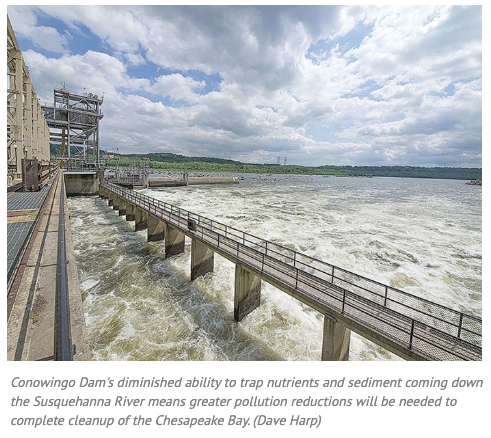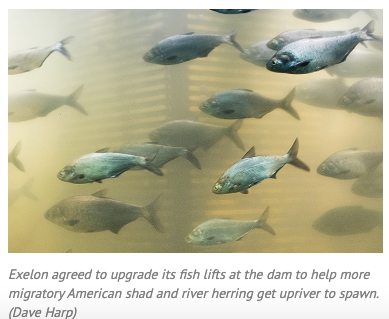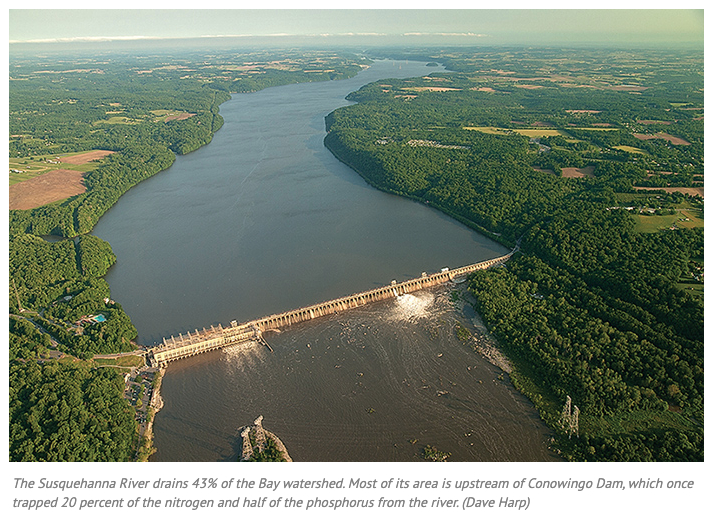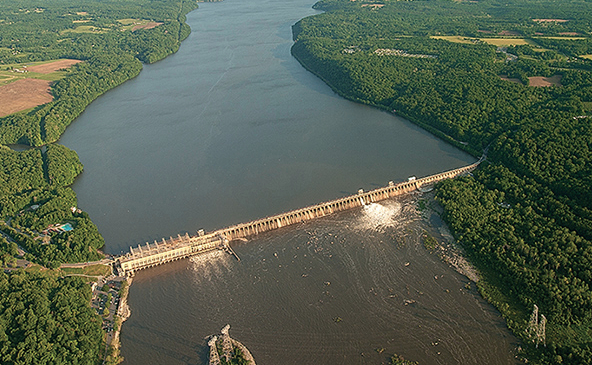 Environmental groups and some rural Maryland officials are calling on federal regulators to reject the deal that the state has reached with the owner of the Conowingo Dam to address the harm the hydropower facility has caused to the Susquehanna River and the Chesapeake Bay. Spurred by that opposition, a bipartisan group of state lawmakers is making a bid to block the agreement through legislation.
Environmental groups and some rural Maryland officials are calling on federal regulators to reject the deal that the state has reached with the owner of the Conowingo Dam to address the harm the hydropower facility has caused to the Susquehanna River and the Chesapeake Bay. Spurred by that opposition, a bipartisan group of state lawmakers is making a bid to block the agreement through legislation.
Nearly 60 comments, the vast majority critical, have been filed with the Federal Energy Regulatory Commission concerning the dam relicensing agreement announced in late October between the Maryland Department of the Environment and Exelon Corp. Along with a petition bearing more than 600 names, they argue that the settlement falls far short of remedying the ecological harm the dam has caused in the lower Susquehanna River and Upper Bay.
According to MDE and-Exelon announcements, the company pledged to spend more than $200 million over the next 50 years on projects intended to rebuild eel, mussel and migratory fish populations in the Susquehanna and to reduce nutrient and sediment pollution flowing into the Upper Bay.
But the Nature Conservancy, Chesapeake Bay Foundation and Waterkeepers Chesapeake have filed extensive critiques of the settlement, saying that’s nowhere near enough. So did the Clean Chesapeake Coalition, a group representing local elected officials in five Eastern Shore counties, which has long argued that the dam is a major unaddressed cause of the Bay’s woes.
Also writing in were dozens of individuals, most of whose comments were form letters, though many appended personal pleas.
The critics argue that the MDE, in its agreement with Exelon, has abdicated its legal authority and responsibility to protect downstream waters from the hydro facility’s operations. They also contend that the state agency abandoned without explanation many of the conditions it originally imposed when it issued a water quality certification for the relicensing in 2018.
 Instead, they say, state officials have settled for much weaker pledges from Exelon of remedial action and financial compensation, which don’t come close to repairing the damage the dam has done and continues to do.
Instead, they say, state officials have settled for much weaker pledges from Exelon of remedial action and financial compensation, which don’t come close to repairing the damage the dam has done and continues to do.
“We recognize that the settlement would reduce some of the project impacts on water quality and the ecosystem,” said Mark Bryer, Chesapeake Bay program director for The Nature Conservancy. “The issue we’re concerned with is whether the settlement mitigates the impacts enough.”
The Bay Foundation, Waterkeepers Chesapeake and Lower Susquehanna Waterkeeper argue that it would violate federal law to accept the settlement. They contend that the agreement imposes “scant” requirements on Exelon to fix the problems the dam has caused. What’s more, they say, many of the things the company has pledged to do are part of a side agreement that won’t be written into Conowingo’s federal operating license, which they say makes them unenforceable.
The Clean Chesapeake Coalition shares many of those concerns. By accepting this deal, the group contends, the state is squandering a “once-in-a-lifetime opportunity to measurably and cost-effectively improve chances for Bay restoration and lasting water quality improvement.”
The critics are calling on the Federal Energy Regulatory Commission to send the state and Exelon back to the negotiating table, or to convene a technical conference or some other proceeding to address their complaints about the shortcomings.
“The Susquehanna River is a public resource and should not be sold off to a private company for exclusive use without ensuring that the impacts to the public, waterways, and aquatic life have been properly mitigated,” wrote Lydia Meeks, a social studies teacher at a Queen Anne’s County school, in one of the individual comments filed protesting the deal.
Ecosystem impacts
Arguments over what to do about Conowingo’s ecological impacts have been going on for decades. The 94-foot high dam straddles the lower Susquehanna in Maryland, about 10 miles from the mouth of the Bay. Exelon describes it as the state’s largest source of clean, renewable energy, producing enough electricity to power 165,000 homes.
But since the dam’s completion in 1928, it has effectively blocked many migratory fish from getting upriver to spawn. It’s also impaired the upriver migration of American eels, which in turn has depleted freshwater mussels that once helped filter nutrients and sediments out of the river.
 Moreover, it has complicated Bay restoration efforts because the 14-mile reservoir it creates has reached its capacity to trap sediment from upstream sources that flow down the river.
Moreover, it has complicated Bay restoration efforts because the 14-mile reservoir it creates has reached its capacity to trap sediment from upstream sources that flow down the river.
As a result, nutrients and sediment from farm runoff, municipal wastewater and stormwater now flow into the Chesapeake, where they contribute to algae blooms and other water quality woes. Plus, whenever a storm hits or heavy rains fall, as they did in 2018, the surge in river flow scours out sediment and nutrients that have built up behind the dam and flushes them downriver. Those pulses also carry a mass of natural and manmade trash and debris that winds up clogging marinas and littering shores farther down the Bay.
The way in which the river’s flow is harnessed also causes ecological harm. The dam’s retention of water, especially during dry summer months as well as frequent large releases to generate electricity, wind up stranding and killing many fish, studies show. It also impairs habitat for freshwater mussels and other aquatic creatures, according to reports cited by The Nature Conservancy.
Exelon agreed nearly four years ago to upgrade its main fish lift at Conowingo to help more spawning American shad and river herring move upstream. But that deal was contingent on the company getting a new 50-year license to generate electricity there.
That was held up until last year by prolonged closed-door negotiations and public posturing over how much responsibility Exelon bears for the pollution. Environmentalists contended the company could easily afford to spend tens of millions of dollars on cleanup, while the company countered that the dam barely breaks even.
Conditions and counterpoints
Gov. Larry Hogan, meanwhile, declared Conowingo a major unaddressed threat to the cleanup of the Bay — a position advocated by the rural elected officials of the Clean Chesapeake Coalition. He vowed to tackle it and demanded an exploration of dredging the nutrient-laden sediment that has built up behind the dam.
Maryland had leverage because under the federal Clean Water Act, no license could be issued unless the state certified that it would not harm water quality. In early 2018, the MDE issued that certification, under the condition that Exelon either clean up the pollution itself or pay the state $172 million a year to have it done.
Exelon sued shortly thereafter, challenging the legality of the state’s demands. It complained of being forced to shoulder an “unfair burden” for pollution from upriver that the dam did not actually generate.
The state won the early rounds in court, but Exelon also filed a petition with the Federal Energy Regulatory Commission arguing that Maryland failed to act within the specified timeframe and forfeited its right to put conditions on the Conowingo license. Then a federal court ruling in another hydropower licensing dispute came along that might support Exelon’s position. Trump administration officials also announced moves to limit states’ authority to use environmental objections to hold up energy projects.
In late October, Maryland and Exelon announced they’d struck what both sides called a comprehensive agreement to address the downstream pollution and other ecological impacts. But it quickly became clear the state had settled for far less than it originally demanded.
The settlement agreement itself showed that less than half of the $200 million Exelon pledged was in cash, with the rest representing the value of facilities or services the company would provide. Actual cash payments would be $61 million over the entire 50-year license, the Waterkeepers argue, with much of that going to species and habitat restoration rather than water quality.
Critics say the agreement also falls short in a couple other key respects. It doesn’t require Exelon to alter its dam operations enough to prevent harm downriver to fish, freshwater mussels and wildlife.
The Bay Foundation and Waterkeepers also say the deal doesn’t address the impacts to water quality downriver and in the Upper Bay from storms scouring sediment and nutrients from behind the dam.
Federal decision pending
The MDE defends the agreement and urges the federal commission to ignore the critics who say the deal does too little to address the dam’s environmental impacts.
“Many commenters seem to believe it would have been easy for MDE to address those impacts by unilaterally imposing huge environmental mitigation burdens on Exelon through the water quality certification process,” lawyers for the agency wrote, “but in reality, such an approach would have undoubtedly resulted in many years of protracted litigation, during which time the environmental impacts of the dam would have languished without any solutions.
“MDE believes Maryland’s citizens and the Chesapeake Bay are best served by the proposed settlement,” they added, “which allows environmental improvements to begin soon, and not by years of expensive and highly uncertain litigation.”
Exelon, in its response, notes that the settlement has the support of the U.S. Department of Interior and U.S. Fish and Wildlife Service, the Pennsylvania state agencies responsible for protecting the environment and fish populations and the Susquehanna River Basin Commission. The company disputed much of the criticism, citing studies done by it and the federal commission staff, and said other claims by critics “are unsupported by the law.”
The company called the agreement reached in October the “last piece of the relicensing puzzle” for Conowingo that it has been pursuing for a decade. Contrary to what critics say, it concluded “there is no compelling reason for additional information, technical conferences, or further proceedings.”
The window to comment on the deal closed Jan. 31. A spokesman for the commission said there is no way to tell when it will rule on the case.
With the deal not yet finalized, its critics hope the state’s lawmakers can act quickly to block it from being approved. Legislation has been introduced in the Maryland General Assembly that, if passed, would prohibit the state from agreeing to waive its authority under federal law to determine whether projects that could impact water quality — such as the Conowingo relicensing — can go forward. The Senate bill has 17 cosponsors from both parties, the House version, 44 sponsors. Hearings on both measures are scheduled for Feb. 19.
“We’re going to have impacts from what happens with this relicensing until 2070, perhaps longer,” said Betsy Nicholas, executive director of Waterkeepers Chesapeake, “so getting it right is really important.”
By Timothy B. Wheeler



Frederick S. Patt says
The impact of the Conowingo Dam on aquatic life is real and serious, and needs to be addressed by Exelon in any licensing agreement.
The impact on water quality and pollution is a red herring. If there were no dam, the impact of the Susquehanna River on water quality would be the same, and would have been much worse in past decades. The problem is the pollution and debris generated by the river watershed, not the dam. This illusion has been created by local groups, particularly that sham organization known as the Clean Chesapeake Coalition that exists solely for the purpose of deflecting any responsibility for Bay cleanup from local counties.
Also, the prospect of dredging raises serious questions about the potential impact on water quality from stirring up long-buried sediment behind the dam.